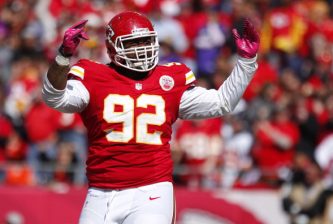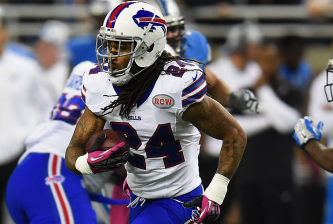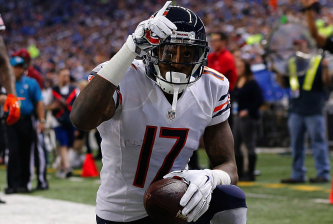
Week 1 of the NFL season was notable for the mindboggling passing statistics that began the 2011 season. You don’t have to be a quarterbacking guru to realize we’re currently in a golden age of gunslingers. Brady, Manning, Brees, Rodgers, Rivers, Roethlisberger, Vick, Ryan, and Schaub are all Pro Bowl caliber QBs and soon perhaps Bradford, Stafford, Freeman, and Newton will join that elite realm. At no time in league history have we seen this many quality quarterbacks up and down the league.
All of those great quarterbacks started the new season with a bang. Week 1 of 2011 went into the history books as the biggest passing week in NFL history… even including Donovan McNabb’s 39 yard debut for the Vikings. All totaled, 14 quarterbacks went over the 300 yard mark. Teams averaged 245.1 yards passing per game compared to just 105.3 yards rushing per game in Week 1. Monday Night Football set an NFL record for most combined passing yards in a game with 933 between the Dolphins and Patriots. Tom Brady threw for a Patriots and MNF record 517 yards including a 99 yard TD pass to Wes Welker. Chad Henne only managed 416 yards in comparison.
In reality though, the explosive numbers through the air to start the season is only a high profile example of a continual evolution of the NFL passing game.
You know the old adage that you have to use the run to set up the pass? Championships are won via running the ball and stopping the run? Don’t believe it anymore. The NFL in 2011 is a passing league, and in truth, it has been for quite some time. Is it because the league wants to gain even more fans because passing makes games more exciting? Is it because quarterbacks are being protected by the commish like delicate flowers? Is it because defenses aren’t allowed to play physical coverage and hit receivers like they used to? Does the lockout have anything to do with the astronomical Week 1 numbers? All of those elements are certainly factors, but perhaps no factor is more evident than good old evolution.
This week I crunched some stats thanks to the massive Pro Football Reference database to try and quantify the changes over the years in the game they call pro football…
The most obvious place to start is with a simple stat – passing yards per game in the NFL. Most of TGS’s research dates back to the AFL/NFL merger in 1970. As you can see, passing yards per game has grown by just over 37% since 1970. That year, passing yards per game registered at 161.4. The NFL reached a low of only 140.9 passing yards per game in 1973. But, in 1979, everything started changing. In a three year period from 1979-1981, passing numbers skyrocketed. This stat grew from 158.8 yards per game in 1978 to 180.4 the next year and 204.4 by 1981. That was largely unchanged by 2006 (204.8 ypg), but the last four years has again seen a noticeable increase to a max total of 221.6 in 2010.
And what of rushing yards per game? That total has dropped slightly since the merger. In 1970, teams averaged 120.4 yards per game on the ground in 31.4 attempts. By 1990, that number had fallen to 113.9 yards per game on 27.8 attempts. In 2000, it was 112.6 yards per game on 27.6 attempts and last year the totals were 114.5 yards per game on 27.2 attempts.
So what would cause such a dramatic increase in passing yards per game? Are quarterbacks across the league merely airing it out more? There was definitely a jump (again) in the late 70s as attempts per game rose from 26.4 to 29.0 in 1979. Since the mid 80s though, attempts per game has been relatively stable in the low 30s. The average in 2010 (33.7) was only two APG higher than 1981 (31.7).
For my money, the two areas of striking growth are in completion percentage and yards per attempt. The two numbers go hand in hand. As quarterbacks complete more passes, obviously their average yards per attempt will increase because more passes are being caught and thus more yards are gained. YPA has grown almost a full yard from its low of 5.68 in 1976 to 6.58 last year (just off a high of 6.60 in 2006). Completion percentage has gone through the roof though. In 1970, quarterbacks were completing barely over half of their passes. Again, the key era here appears to be 1977-1980, where the completion rate went from 51.3% to 56.2%. Since then, the number has continued to grow, especially since the turn of the millennium. Since 2007, NFL quarterbacks have never been below 60% completion percentage in a given season…

Let’s take a timeout quickly. Why did we see a passing explosion in the late 1970s? Every passing number we’ve looked at so far centers on the passing boom in those years. There is one man to blame – Steelers Hall of Fame cornerback Mel Blount. Those of you that know your NFL history will recall the “Mel Blount Rule,” which went into effect for the 1978 season. This meant that defenders could only make contact with receivers within five yards of the line of scrimmage. Consequently, the passing game was opened up like never before. With wide receivers allowed to run freely, the game changed in favor of the passing offense in the late 70s. However, that is far from the entire story.
Another “rule emphasis change” happened in 2004 as officials were encouraged to call more defensive holding and illegal contact penalties. This came after Colts wide receivers were manhandled by the Patriots secondary in the ’03 Playoffs like New England was a vicious bunch of honey badgers. The rule “emphasis” laid down the law that first came with Mel Blount 25 years earlier. Even more rule changes followed to protect quarterbacks at the other end of the passing game. After Bengals QB Carson Palmer went down to a knee injury thanks to a low hit in the 2005 Playoffs, defenders couldn’t hit quarterbacks too high or too low. With both quarterbacks and receivers treated like they’re playing flag football, it’s no wonder the numbers have grown this dramatically.
In the last decade, the NFL has taken step after step forward in its identity as a passing league. While no change has been as transforming as the Mel Blount Rule, the total effect is clearly seen. The growth in numbers is certainly not as dramatic as the late 70s, but the decade by decade totals show remarkable numbers, especially in the latter half of the 2000s.
Here are 300 yard and 400 yard passing games by decade including the 1960s. The number of 300 yard passing games has skyrocketed in the last decade. There was a massive jump from the 70s (149) to the 80s (522). This was likely due to the Mel Blount Rule and the fact that more games were being played with the league also switching from a 14 to 16 game schedule in 1978. This stat again ballooned like Rex Ryan’s waistline as we crossed into the 2000s. From 2000-2010, there were 843 300 yard passing games (75 of which were 400 yard performances). 422 of the 300 yard games occurred from 2006-2010.

In terms of season passing totals, the growth is even more glaring. Over half the league average of starting quarterbacks have had 3,000 yard seasons since 2000. 183 in total from 2000-2010 for an average of 16.6 3000 yard seasons per year. That number increased from an average of 11.8 3000 yard seasons in the 1990s and only 2 3000 yard seasons in the 1970s (again, the rule and schedule changes likely playing a significant role). Furthermore, there have been more total 4000 yard passing seasons from 2000-2010 (51) than there were from 1920-1999 (38)…

And for the grand finale, I examined some arbitrary numbers that might define a “great” year playing quarterback. I set the PFR filters to these numbers…
60% completion, 90.0 Passer Rating, 3500 Pass Yards, 20 TDs
Simple enough parameters, right? There have been 82 such seasons in NFL history. The first season that fit these specifications came from Browns QB Brian Sipe in 1980. Before 2000, there were 27 such seasons in NFL history. Since 2007, there have been 30… including 20 the last two seasons.

As we move forward through the 2011 season, I would only expect these numbers to continue to grow. We could realistically see 15 QBs reach the above thresholds this season. Several more will throw for 3,000 yards and complete passes at a 60% rate. The numbers we saw this past week are likely here to stay. In the future, who’s to say whether or not a limit is ever reached in passing stats? If Rex Grossman can become a consistently great QB in Washington this year, we’ll know anything is possible.




